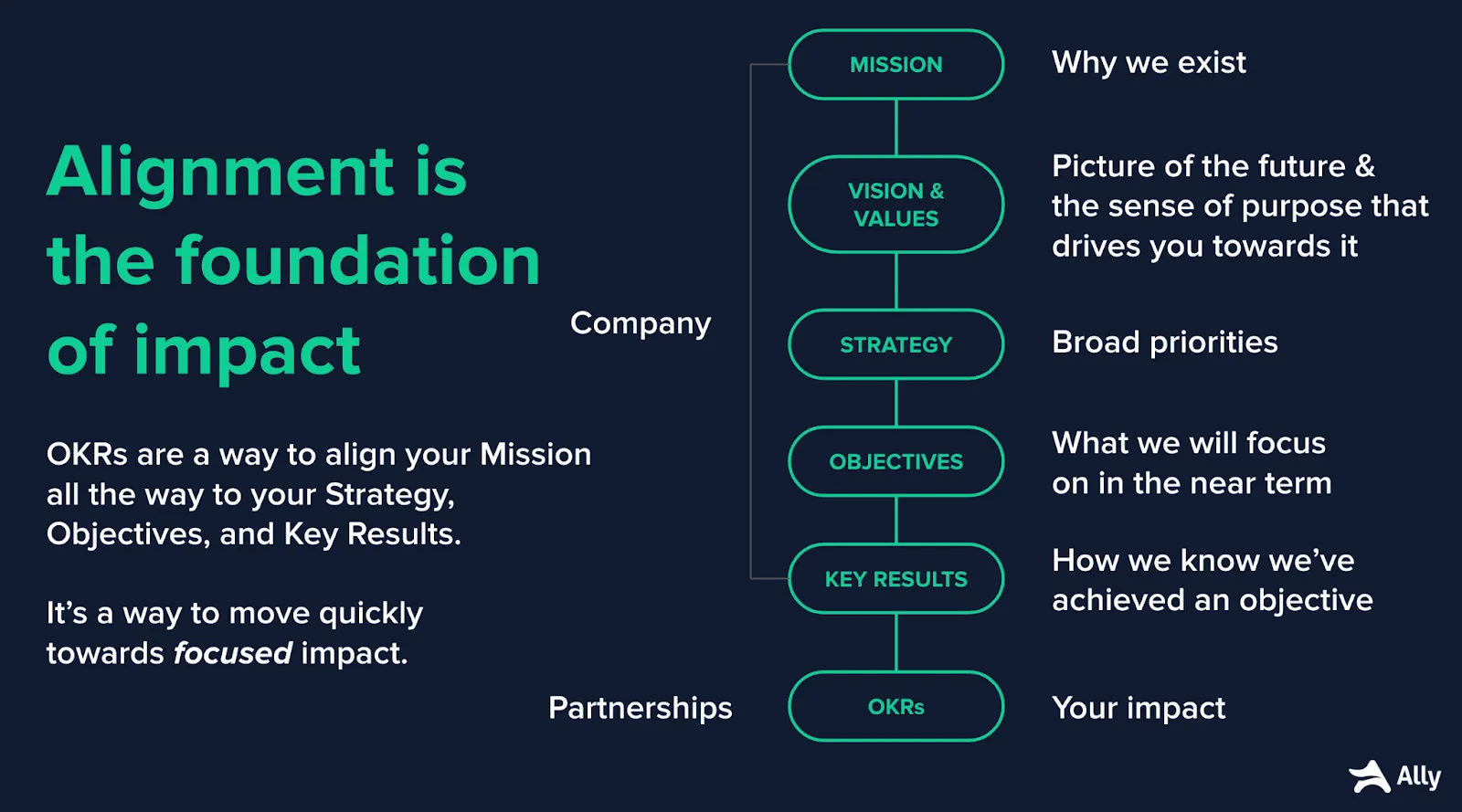As a partnerships leader, you understand that internal alignment sets the foundation for the kind of impact you want to have at your company. One of the best ways to drive this forward is with a widely adopted goal management practice — the OKR (or objectives and key results) framework.
Whether you’re tasked with managing an existing reseller program, course correcting affiliates, or launching a new referral channel, having the right OKRs in place demonstrates your ability to think strategically and get through to execution.
Why OKRs for partnerships?
Any outcome-focused team needs to set clear goals and chart a path towards achieving them. OKRs are the most widely adopted goal management methodology in SaaS, and are effective in communicating both the bigger picture (the objective) and the measurable results that prove an objective is complete (the key results).
As more companies adopt OKRs at the company level, partnerships leaders must get on board and become proficient at utilizing them to create the alignment, transparency and focus we all need to succeed.
In this guide to OKRs for partnerships, we’ll cover:
- What OKRs are, and what they aren’t
- How OKRs are best used
- OKRs vs. KPIs
- Bonus access to an OKR template designed for partnerships leaders
Getting started: What to know about OKRs
OKRs often get a bad reputation. Eyes roll when they start to add more work to your day. I’ve felt this pain firsthand, having watched OKR adoption fail at two other companies.
Now that I’ve worked with the world’s top OKR consultants, my biggest takeaway after seeing hundreds of OKR rollouts is that your OKR success is only as good as your commitment to them. OKRs are a long-term investment in your people, your work culture, and your business. This investment starts long before individuals in your partnerships write their first OKR. I’m not saying that you can’t trailblaze and use OKRs for your team — you absolutely can — but we know that success in partnerships is dependent on many other stakeholders. If everyone doesn’t understand the rules of engagement collectively, it’s pretty hard to play the game effectively.

Questions that leadership should consider in an OKR rollout
- Are OKRs part of a broader business transformation that needs to take place? How are they integrated?
- Is any change management and strategic communication required to set up OKRs to succeed?
- What are the appropriate business rhythms to wrap around OKRs or integrate them into?
- Do we as a leadership team understand OKR fundamentals including how to write them properly ourselves?
- Does the company have the right mission, vision, values, strategy, and its own OKRs to serve as inputs to the partnership team’s OKRs?
Read more: Critical points of trust within your ecosystem.
Defining OKRs
OKRs are a goal-setting and strategy execution system that helps drive alignment, agility and impact. Done correctly, they should force you to separate what really matters from everything else, and set clear priorities.
Let’s break down the different parts of OKRs:
- Objectives: These are what you want to achieve and why. They are meant to be lofty, ambitious statements that motivate people to pursue the outcome with gusto. In a partnership team you should likely have between three to five.
- Key Results: How you’ll measure success (outcome). The best ones are metric based, able to answer “yes or no” to, and either leading (good) or lagging (best) indicators. No more than five per objective.
- Projects: These are focused efforts (outputs) that help you achieve key results.
In practice, OKRs are a recipe to help companies shape their priorities, enable everyone to align into them, and to create an unrelenting focus on growth and innovation. This works best in a culture that fosters psychological safety, and when done properly, this leads to the creation of an outcome-focused mindset, rather than an output one.
See more: Revenue-focused goals following partner activation.
Example of a good partnerships OKR
Objective:
Diversify the types of partners we work with so that we are able to move into and win new markets.
Key results:
- Create a new category of partners and recruit 100 in new markets (leading indicator)
- Achieve $250,000 in revenue through Partners in new markets (lagging indicator)
- Achieve a minimum of 5% market share in each new market (lagging indicator)
What OKRs are not
I mentioned earlier that OKRs often get a bad rap — and that’s often because they get used for the wrong reasons.
- OKRs are not KPIs, and should not be used to measure business as usual.
- They are not for micro-managing people.
- They are not for highlighting people missing targets.
- They are not a measure for reward and compensation (this kills ambition and people naturally start sandbagging their OKRs).
- They are not a “set and forget” goal setting framework.
The three types of objectives
The objectives in your OKRs should always align around one of three themes:
1. Driving growth
Example objective: Accelerate the company focus on partnerships so that they account for a sizable chunk of annual recurring revenue (ARR) in the next 12 months.
2. Driving innovation
Example objective: Foster a culture of experimentation with developer partners so that we can accelerate our product roadmap and build things we weren’t even thinking about.
3. Driving change
Example objective: Create a world-class partner attribution practice so that we unquestionably demonstrate the value our partner ecosystem adds to the company.
OKRs vs. KPIs
If your OKRs aren’t driving growth, innovation or change, they are likely not ambitious enough or you’re merely tracking KPIs (key performance indicators) — items that are business as usual. That’s not to say that KPIs aren’t critical to your day to day, but OKRs aren’t meant to focus on the day-to-day. They’re meant to shine a spotlight on the things that matter most across a longer period of time.
KPIs are put in place as health metrics to measure business as usual. And there can be a very, very long list of KPIs in SaaS and in partnerships. Sometimes, we forget the word “key” and they end up being a list of, well, indicators.
This is why we limit the number of objectives and correlating key results. OKRs are not meant to track everything you do.
Let’s use an analogy to illustrate the difference
You’re dreaming of the perfect road trip. So you take to Google to start discovering the ideal experience, and you decide the Road to Hana in Hawaii is where it’s at. Strategy is this process of deciding the destination, it helps you make a decision on where you want to go. Now that you’ve made that decision, you need to rent a car and put that destination into your GPS so you stay on the right path and course correct if needed. OKRs are your GPS — they help you understand if you’re on the right path and make corrections to the course if needed. OKRs are an output of strategy, not an input.
Lastly, as you drive to Hana, you have a dashboard that tracks all sorts of metrics like temperature, oil level, and gas. As long as those metrics are at reasonable levels, you don’t pay much attention to them, what matters most is getting to Hana. But of course, if you’re low on gas, you change your course and get to a gas station. KPIs are your dashboard. They tell you if everything is alright. You measure them regularly and probably report on them, but as long as they're healthy they don’t become your focus. However, if an important KPIs becomes unhealthy, you may include it as an OKR to bring it back to an acceptable level.
OKRs help you decide where you and your team want to get to, the path that will get you there, and the metrics that indicate whether you’re getting the results you want to.
OKRs: a system for success
The best partnerships have the best outcomes.
OKRs are a system that increases the likelihood of those outcomes, by creating alignment, transparency, and focus on the things that matter most. They may come in different flavors, but what matters is that everyone is on the same page and playing by the same rules.
Partnerships OKRs template

Editors note: This was article was originally written and published in 2021 when Ty Lingley was Head of Partnerships at Ally.io.

















